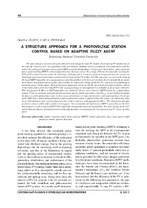| dc.contributor.author | Elzein, Imad A. | en |
| dc.contributor.author | Petrenko, Y. N. | en |
| dc.coverage.spatial | Минск | ru |
| dc.date.accessioned | 2017-11-02T11:00:09Z | |
| dc.date.available | 2017-11-02T11:00:09Z | |
| dc.date.issued | 2017 | |
| dc.identifier.citation | Elzein, Imad A. A structure approach for a photovoltaic station control based on adaptive fuzzy agent = Структура управления фотоэлектрической станцией на основе адаптивного нечеткого агента / Imad A. Elzein, Yury N. Petrenko // Системный анализ и прикладная информатика. - 2017. – №3. - С. 40-48. | en |
| dc.identifier.uri | https://rep.bntu.by/handle/data/34316 | |
| dc.description.abstract | The solar energy is directly converted into electrical energy by solar PV module. Each type of PV module has its own specific characteristic corresponding to the surrounding condition such as irradiation, and temperature and this makes the tracking of maximum power point (MPP) a complicated problem. To overcome this problem, many maximum power point tracking (MPPT) control algorithms have been presented. Fuzzy logic (FL) has been used for tracking the MPP of PV modules because it has the advantages of being robust, relatively simple to design and does not require the knowledge of an exact model where a mathematical model of the PV module, DC-DC converter, are used in the study of FL based MPPT algorithm. It is suggested to present this problem in the form of two-folds; first to identify the deviation of the power to maximum power point, and secondly, to control the voltage of the DC-DC converter corresponding to maximum power. In this paper, the first discussion approach will stress out the integration of model predictive control in maximum power point tracking MPPT and as progressing a second approach is identified as fuzzy logic controller FLC and perturb & Observe P&O algorithms are analyzed. All are interrelated to MPPT model for a photovoltaic module, PVM, to search for and generate the maximum power; in this case what’s called Pmax. As per the first technique the focus is on the optimal duty ratio, D, for a series of multi diverse types of converters and load matching. The design of the MPPT for a stand-alone photovoltaic power generation system is applied where the system will consist of a solar array with nonlinear time varying characteristics, and a converter with appropriate filters. The integration of model predictive control will be addressed first in this paper. The second fold will implement an MPPT system that use the FLC and compare it with a classical MPPT P&O algorithm through the utilization of Simulink. The novel design in the FLC will be based on the use of asymmetrical membership functions to compensate for the asymmetrical P-V curve of solar panel. | en |
| dc.language.iso | en_US | en |
| dc.publisher | БНТУ | ru |
| dc.subject | Photovoltaic station | en |
| dc.subject | Maximum power point tracking | en |
| dc.subject | MPPT | en |
| dc.subject | Control algorithms | en |
| dc.subject | Fuzzy logic agent | en |
| dc.subject | Model predictive control | en |
| dc.subject | Optimal duty ratio | en |
| dc.subject | Фотоэлектрическая станция | ru |
| dc.subject | Выходная мощность - максимально | ru |
| dc.subject | Алгоритм управления | ru |
| dc.subject | Нечеткая логика - агент | ru |
| dc.subject | Упреждающее управление | ru |
| dc.subject | Сигнал управления - оптимальный | ru |
| dc.title | A structure approach for a photovoltaic station control based on adaptive fuzzy agent | en |
| dc.title.alternative | Структура управления фотоэлектрической станцией на основе адаптивного нечеткого агента | ru |
| dc.type | Article | ru |
| dc.relation.journal | Системный анализ и прикладная информатика | ru |
| local.description.annotation | Преобразование солнечной энергия непосредственно в электрическую осуществляется солнечными модулями в составе фотоэлектрической станции (ФЭС). Каждый модуль имеет свою характеристику зависимости генерируемой мощности от напряжения (P-V) при определенных условиях окружающей среды - интенсивности солнечного излучение и температуры. Характеристика P-V имеет уникальную точку максимальной выходной мощности (МВМ) и ее отслеживание является достаточно сложной проблемой. В мировой практике предложено большое разнообразие алгоритмов, обеспечивающих функционирование ФЭС при МВМ. Предложено рассматривать решение этой задачи в два этапа: 1 – выбор алгоритма идентификации отклонения и 2 – пректирование контроллера управления преобразователем постоянного тока, обеспечивающего величину напряжения, соответствующей точке МВМ. Наиболее совершенными характеристиками обладает предложенный адаптивный нечеткий агент, функции принадлежности (ФП) которого разработаны с учетом характерных уникальных свойств ФЭС-нелинейности характеристики P-V и ее несимметричности относительно точки МВМ. Приведен пример формирования ФП. Эффективность предложенных решений подтверждается результатами проведенного численного эксперимента на разработанной имитационной модели в среде MATLAB-Simulink. При этом адаптивный нечеткий агент обеспечивает сокращение времени выхода на заданную траекторию примерно вдвое. | ru |

